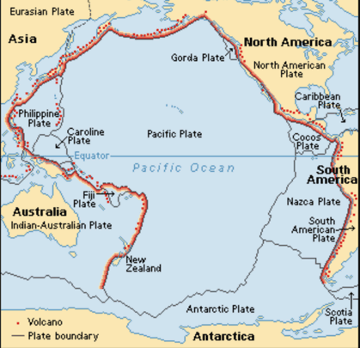
The “Ring of Fire” is the chain of volcanoes that rims the Pacific Ocean.
Aurania’s heliborne geophysical survey flown in 2017 identified a large number of features that could be porphyries. An independent geophysicist who worked with the data concluded that over 30 features were high-priority targets as porphyries.
Porphyry deposits produce approximately 60% of the world’s copper. Most of these deposits lie in the Pacific Rim, also known as the Ring of Fire, an arc that stretches from Papua New Guinea to the southern tip of Chile.
The copper is contained within roughly cylindrical granitic bodies that are remnants of the magma core beneath volcanoes. Copper typically occurs with molybdenum and some porphyries contain gold and silver as well. Mineralization is mainly in veins as shown in the photograph below, and the veins are sufficiently closely spaced so that the whole rock mass can be mined on a large scale, usually as an open pit, but some are mined by block-caving, a method of mining bulk tonnages in an underground mine.
Porphyries were one of the first deposits in which alteration minerals were seen to be arranged in a more or less concentric pattern around the mineralized core. This phenomenon was published 50 years ago in a paper that is famous in the exploration fraternity by Lowell and Guilbert in 1970. The recognition of this systematic arrangement of alteration minerals meant that one could vector in towards the mineralized core of the deposit by mapping the minerals that formed in response to the presence of the magma from which the porphyry developed. These roughly concentric mineral zones formed in response to decreasing temperature away from the magma and gases and fluids that were escaping from the magma.
Copper and other metals in porphyries are concentrated in veinlets that formed as the magma was cooling. As the magma solidified, so the metals and silica were concentrated into salty water water with some gases such as carbon dioxide and hydrogen sulphide (the gas that smells like rotten eggs). As the solidifying magma fractured, the fluid could expand into the space created by the fractures, resulting in a pressure drop and cooling, resulting quartz accumulating along the fracture walls to form veinlets, while the metals deposited as sulphides such as chalcopyrite and bornite (copper minerals), molybdenite and pyrite.
The average grade of porphyries around the world is low – only 0.7% copper, but they are so huge that they can be economically extracted in huge mines that rely on economies of scale for profitability. Many porphyries in dry climates have layers of relatively high-grade copper over them. These “enrichment blankets” are formed by the pyrite, an iron sulphide that forms a halo above and beside most porphyries, oxidizes and forms sulphuric acid that dissolves the copper from the upper part of the porphyry and this is deposited at the water table, beneath which there is no further oxidation. So, all of the copper from above the water table is concentrated into a relatively thin layer at the water table, forming the layer of relatively high-grade copper, that normally exists in the copper mineral called chalcocite. These relatively rich layers are therefore also called “chalcocite” blankets. These blankets of enriched copper are fundamentally important to the economics of most porphyry deposits because their high-grades provide high revenues that are used to pay down the capital cost of the mine.






